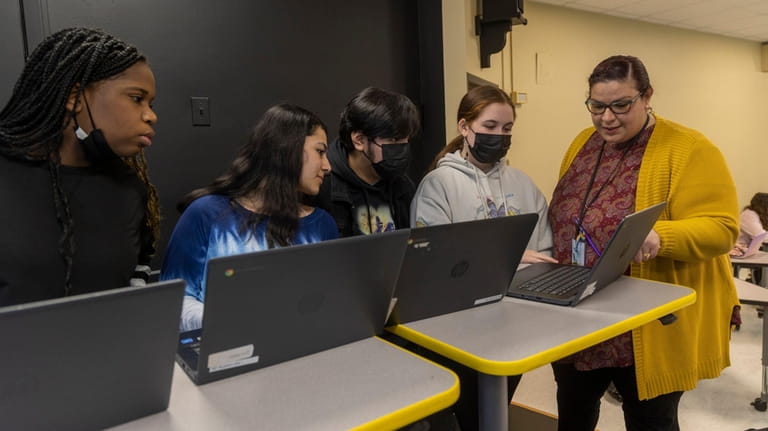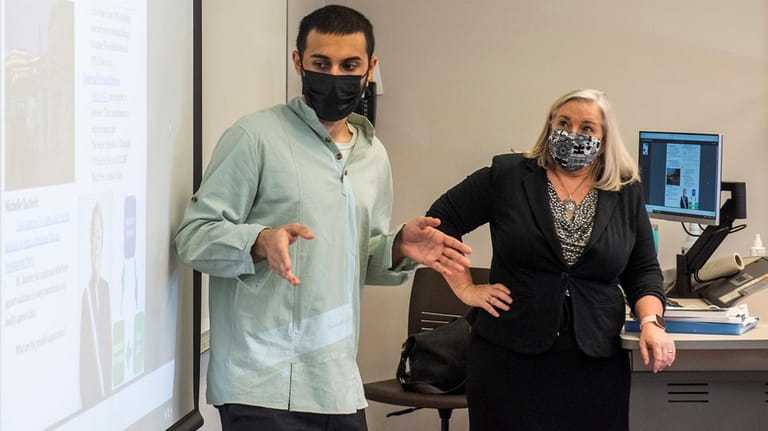Interest, fear on minds of students studying Russia-Ukraine war
Professor of Political Science Katie Laatikainen watches as junior ,during her International Relations class at Adelphi University, in Garden City, March 22, 2022. Professor Laatikainen incorporates the unprecedented world event of the Ukrainian invasion in her classroom to affect students' learning of current events and polical posturing on a global scale. Credit: Johnny Milano/JOHNNY MILANO
The Russian invasion of Ukraine is offering lessons in real time for students whose social media accounts are now filled with videos of tanks, refugees and young people huddled in bomb shelters.
The images on TikTok and Instagram have brought an immediacy to the conflict, intensifying students’ interest and fear, Long Island teachers said.
“The constant question we get is, ‘Does this mean World War III?’ ” said Dean Bourazeris, a seventh-grade social studies teacher in West Hempstead. “It is walking a tightrope to make the students feel safe while also providing them with historical information.”
Teachers and professors from elementary school to the college level are using the crisis to encourage students to critically analyze what they see on social media for bias and propaganda, look for primary and historical sources, and make connections to historical themes.
What to know
- Many students are seeing a flood of social media images from the Russian invasion of Ukraine, which has sparked unusual student interest in a global event and fear of a world war.
- Teachers are using current events to illuminate historical events. They’re asking students to critically analyze social media content for authenticity versus propaganda and fake or misleading imagery.
- The war is the first time many students are learning about NATO, the Cold War and policies on nuclear arms and deterrence.
“We’re bridging the gap between historical events and what’s happening in their everyday lives,” Bourazeris said. “I’m giving life to things that may seem dull and boring to them because they only read about it in a textbook, and so when we draw parallels between the War of 1812 and the current conflict, they will see that history is always living in their lives whether they see it or not."
The war began Feb. 24 when Russia unleashed missile and long-range artillery attacks on Ukraine and then began to advance forces amassed along the border. Russian leaders justified the incursion by claiming pro-Western Ukraine was a security threat to Russia, and said they were liberating Ukrainians from neo-Nazis who they claimed were committing “genocide” against pro-Russian separatists in a breakaway region in Eastern Ukraine. Now, Russian President Vladimir Putin says Ukraine has no right to be a sovereign nation and belongs under Russian control.
Ukraine’s military has been fighting Russian-aided separatists in the self-declared Donetsk People’s Republic since 2014, the same year Russia took control of Ukraine’s Crimean Peninsula.
Ariana Cassa, who teaches ninth-grade Global History and Geography in West Hempstead, said students’ social media accounts have been flooded with posts from Ukraine, in a way not typical of current events, “from every age and perspective that allowed them to step into a world that is not their own. … That’s what makes the connection. That’s what increases their interest.”

Ariana Cassa with students, from left, Christina Guerrier, Yeris Alvarado, Juan Mejia, and Isabella Ferreira at West Hempstead High School. Credit: Howard Schnapp
The conflict has presented a unique opportunity, she said, to “include students’ voices and interests to examine the modern world … to use the historical learning skills they learned to explore and engage themselves with current events outside the classroom.”
One of her students, Juan Mejia, 15, said he talked with his family and teacher "just to get a better grasp of all this."
"It definitely gives me a lot of fear knowing what this could cause for our future," he added.
Fitting into college curriculum
The crisis fit perfectly into the curriculum of college courses on international relations and law, and again, the heightened concerns of students have fueled classroom explorations.
“They are so motivated,” said Katie Laatikainen, professor of political science and international relations at Adelphi University in Garden City, noting that her office hours are now filled with students coming in to discuss the war. “It sounds terrible, but it makes the teaching easier because they can immediately see the relevance of it.”
Students are seeing the machinery of international relations and institutions in action, from the United Nations, International Court of Justice, and the Geneva Conventions, she said.
“It’s quite interesting — this is one of those moments where the shape of international politics for the next decade or more is being transformed,” she said, giving her students the chance to apply the conceptual tools they are learning in their courses, including International Law and Organization. “They take the elements of the course and apply them, and it is so gratifying.”

Rakan Euhulaiqa gives a presentation in the class of Katie Laatikainen, professor of political science and international relations at Adelphi University in Garden City. Credit: Johnny Milano
At Stony Brook University, with its many international students, interest in the crisis also is intense, said Juliette Passer, a Ukraine-born lawyer who teaches courses on international law and human rights.
She said that in her view, the crisis is inspiring a needed focus on global issues. Students “do understand that human rights issues are involved, but I am glad they are developing a more sophisticated global outlook and can analyze what NATO and our NATO allies can do and are planning to do … we as Americans have had tunnel vision for too long. It’s unfortunate that Ukraine is what is putting this into focus.”
Teaching younger students
While the concepts revolving around the conflict can fit neatly into higher-level coursework, some teachers of younger students have used emotional engagement with the crisis.
In Elwood, eighth-grade middle school teacher Wendy Braxton took a week to consider how to introduce the topic. She came up with a “gallery walk” of enlarged photos of war images — a mother and child, a falling building — for students to view with “Enigmatic: The String Quartet Tribute to Radiohead” playing in the background.
“It was very passionate music. The photographs were very dramatic photos,” said Braxton, adding that students then wrote a reflection on an image they selected, and “I got some really powerful responses.”
Alan Singer, an education professor at Hofstra University who instructs aspiring social studies teachers, said approaches vary with student age, and that very young children can be approached using children’s books such as Dr. Seuss’ “Butter Battle Book.”
The crisis also opened a way to engage “kids in civic action. Hofstra is collecting medical supplies and clothing for refugees. They can raise money, food banking, medicine. … They study something and make a decision to become an active participant in addressing it.”
Some of the middle and high school classwork will involve civic action, but that impulse resonates even with the sixth-graders in Garden City teacher Robyn Madden’s classes.
“They are showing tremendous empathy,” she said. “They want to help. They want to collect items. They want to make donations.”
Yet, they are young enough that she was concerned to create a “safe and comfortable space. I used a lot of maps. I didn’t use a lot of images that came in through the news — that’s scary. And I constantly reassure them that the majority of people in this world don’t want a war. They want their kids to be safe like your parents want you to be safe.”
They continue to talk about the crisis even as they’ve returned to their current subject matter — ancient India and Hinduism, Madden said. But they are also working on digital citizenship, examining online resourcing, “deciphering whether information is accurate, who is behind the information,” she said. “That’s the realm we’re going to be going to now, really showing students how they can develop the skills they need to be an informed and responsible citizen.”
The invasion and humanitarian consequences have impacted teachers, too, and in the case of Adelphi International Studies Professor Jonathan Cristol, it has shifted his approach significantly, he said. Cristol said he generally tells students his opinions and encourages them to come to their own conclusions. But in this case, he said, he thinks there is only one correct conclusion.
“In a field in which for 20 years I emphasized that international life and conflict is highly nuanced, a lot of gray areas, [where] I tell my students … that things are more complicated than they seem, seldom black and white, this has largely altered that,” he said. “This is a case where there is not a gray area here. It’s a case of right and wrong, good and bad, and I’m not shying away from framing it that way.”
He added, “The idea of equivocating on that, to be somehow balanced or evenhanded, I would say it would be morally disgusting. I don’t think I’d be able to live with myself or sleep at night if I wasn’t presenting this as a reality, as probably the most important event in any of our lives.”

